New York Sea Grant-organized Harmful Algal Bloom (HAB) workshops connect diverse stakeholders with HAB science experts to help mitigate the environmental and economic impacts of related outbreaks
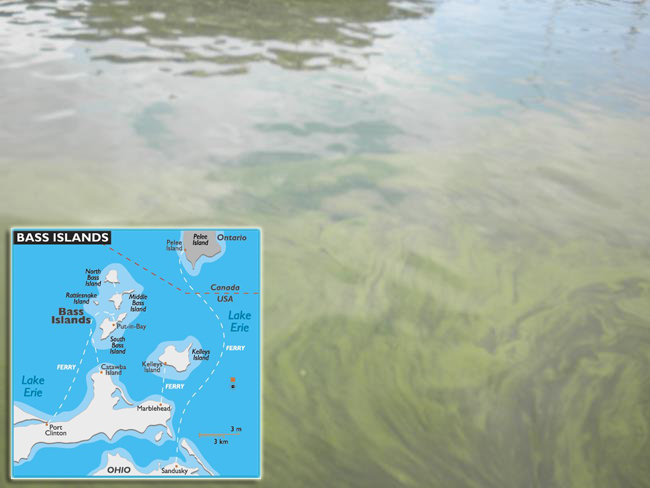
As seen in this September 2011 picture, it's pretty easy to spot the HABs that plague Lake Erie's waters in the summer months. Most HABs are caused by planktonic bacteria, which are suspended in the water and rely on currents to move them. Near Ohio's South Bass Island, you'll find Microcystis blooms, which have been at high levels in recent years during the summer months. Photo: Paul C. Focazio, NYSG.
Buffalo and Oswego, NY, June 6, 2014 — Harmful algal blooms (HABs) - the abundant or excessive growth of algae - are nothing new to Lake Erie. “It’s been mainly a problem in Ohio waters in the Western Basin, but it has now been seen as close as Presque Isle Bay in Pennsylvania,” said NYSG's Coastal Education Specialist Helen Domske at the 2014 State of Lake Erie Meeting this past April. At the event — the 21st of its kind, attracting well over 200 anglers and interested citizens annually — Domske also said that while not all algae growth is toxic, swimmers are cautioned to avoid waters in which these growths are seen. Excess presence of algae can be harmful even after death, decreasing oxygen levels for fish and other aquatic life.
Domske, who is based at the University at Buffalo, recently wrote about the threat that HABs pose on our waterways in "Lake Erie," a four page NYSG fact sheet (pdf). Ohio Sea Grant, one of NYSG's Great Lakes Sea Grant partner programs, also offers information on the topic via a four-page fact sheet, "Harmful Algal Blooms in Ohio Waters" (pdf). Included in OHSG's content are answers to the questions "What causes HABs to form?" and "What can I do about it?"
Why are we seeing more HABs in our waters? "One reason is due to heavy nutrient input from watersheds and climate changes," said NYSG Fisheries Specialist Dave MacNeill, who is based at the State University of New York at Oswego. HABs occur when populations of certain noxious blue-green algae (classified as cyanobacteria) produce toxins in embayments and nearshore areas. The toxins cause human illness from direct contact or ingestion of lake water and kill fish and wildlife.
"This is an issue that effects all the Great Lakes and it has fairly serious implications for human and animal health as well as coastal economies," said MacNeill at a HABs workshop he helped organize in Erie, Pennsylvania last summer. "This is why it is so important that Sea Grant and its partners collaborate to gain a better understanding of what is going on and how we can combat the issues."
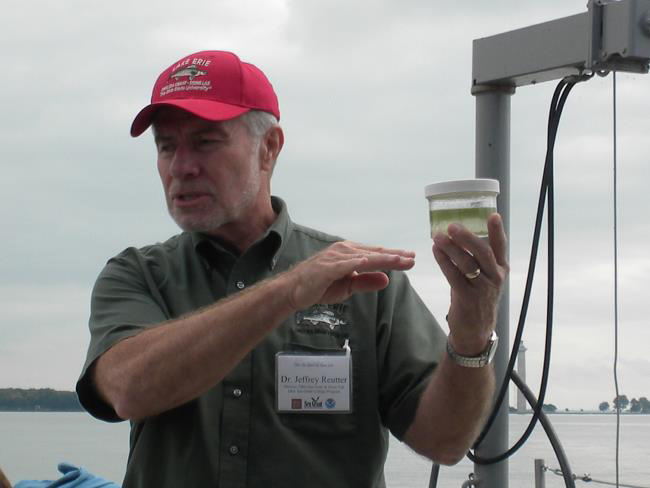
Knowing what triggers HABs is key to reducing their occurrence and impacts - they may be minimized, and some completely avoided, by reducing the nutrients (such as phosphorus or nitrogen) and pollutants added to the water. "Everyone agrees that phosphorus reduction is the key to reducing harmful algal blooms," says Ohio Sea Grant Director Jeff Reutter (pictured below aboard the R/V Gibraltar III in the waters around Ohio's, Bass Islands, a small series of islands in the southwestern corner of Lake Erie). "The problem is of such a large magnitude that a 5 or 10 percent reduction in phosphorus won't get us anywhere. We'll need to reduce it by 65 or 70 percent." Photo: Paul C. Focazio, NYSG.
Last July, NYSG's MacNeill organized National Oceanic and Atmospheric Research (NOAA)-funded workshops through the Ecology and Oceanography of Harmful Algal Blooms (ECOHAB) Program for Lakes Erie and Ontario, which brought together 60 diverse stakeholders representing county government, marinas, lakefront communities, sportsmen groups and internationally-renown research institutions to discuss HAB formation, impacts, and citizen monitoring and reporting guidelines.
Then, a month later, NYSG partnered with Pennsylvania Sea Grant to develop a companion workshop for 60 stakeholders representing county and state agencies and academia in PA, NY, and Ohio. “The timing of the workshop for health and environmental managers on HABs could not be more perfect as the discovery of harmful blue-green algae was recently confirmed in Presque Isle Bay,” said one participant.
NOAA's National Centers for Coastal Ocean Science Program Analyst John Wickham reported the summer 2013 HABs Sea Grant workshop series as the best of their kind that he has seen and recommended them as templates for other Sea Grant outreach programs on HABs.
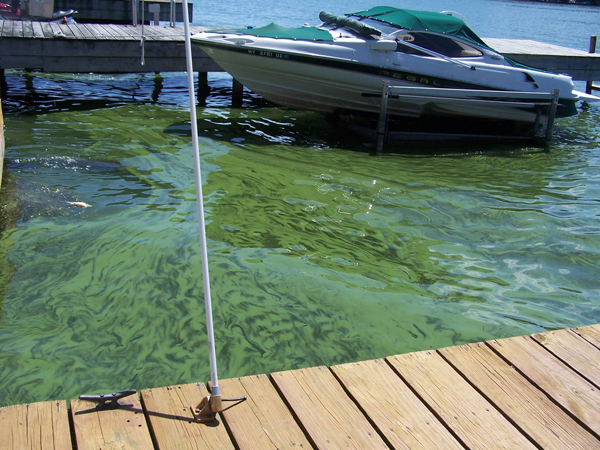
When it comes to increased incidence of harmful algal blooms having a significant impediment to recreational water use and coastal community economies, one Lake Ontario community - Sodus Point, NY (pictured above) - reported a $200,000 revenue loss from a HAB outbreak in 2010. Similar communities in the Lake Erie region have filed considerable financial burdens due to such occurrences as well. Photo: SUNY ESF.
"These workshops on harmful algal blooms connected diverse stakeholders with related science experts to help mitigate HAB-related environmental and economic impacts in both New York and Pennsylvania," said MacNeill.
As a direct result of the Sea Grant workshops, Sodus Bay is incorporating workshop information into its watershed management plan to mitigate HAB outbreaks. Pennsylvania state agencies developed a HAB response plan at the workshop in their state.
In addition to Sea Grant programs in New York and Pennsylvania, partners on this effort included NOAA National Ocean Service ECOHAB and HAB Event Response Programs, Cornell Cooperative Extension, the New York State Department of Environmental Conservation, State University of New York (SUNY) College of Environmental Science & Forestry, Stony Brook University and a number of citizen environmental groups.
— Articles above and below compiled by Paul C. Focazio, NYSG's Web Content Manager
On Blog: Algae Conditions in Lakes Ontario and Erie
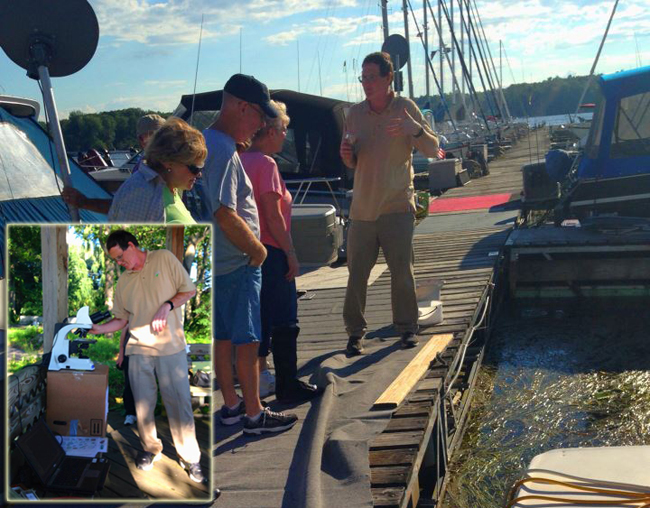
Photos: Save Our Sodus; Composite by Paul C. Focazio, NYSG.
At Save Our Sodus' August 2013 water quality gathering at Wayne County,
NY's Oak Park Marina—situated on Sodus Bay, one of Lake Ontario’s
major embayments—attendees went "Under the Microscope" for a
walk-and-talk with researcher Dr. Greg Boyer. In the water samples drawn, all different types of algal were
found, but none of the toxic kind, like Microcystis.
Boyer, an often NYSG-funded investigator from the State University of New York (SUNY) College of Environmental Science & Forestry, will soon release finding in a research journal from a separate and recent study that he and his team conducted about HABs in Sodus Bay.
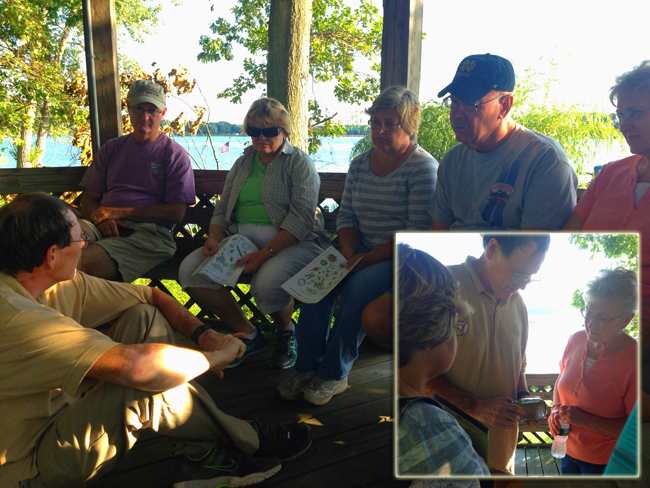
Photos: Save Our Sodus; Composite by Paul C. Focazio, NYSG.
Boyer spoke about blue green algae, answering such questions as "Can you visually identify a bloom?" Just a month prior, in July 2013, Boyer provided details on Lake Ontario's algal issues while aboard the U.S. Environmental Protection Agency's 180-foot R/V Lake Guaridan. His answers to the questions "Are They Harmful?" and "Are They Found in Lakes Ontario and Erie?" are included in a blog post from NYSG's Web Content Manager Paul C. Focazio. And, of all of the factors he identifies that cause algal blooms, Boyer pointed to one that humans can control. Photo: Save Our Sodus.
On YouTube: Harmful Algae Conference Raises Awareness of This Great Lakes Issue
Story filed by Paul Wagner for WICU-TV (a Erie, PA NBC-affiliate station) and WSEE-TV (a Erie, PA CBS-affiliate station)
Erie, Pennsylvania, August 21, 2013—The recent troubling discovery of harmful blue-green algae in Presque Isle Bay was the focus of a regional conference last week (August 14th) at the Tom Ridge Environmental Center. The algae was found near some marinas and quiet, calm areas of the bay.
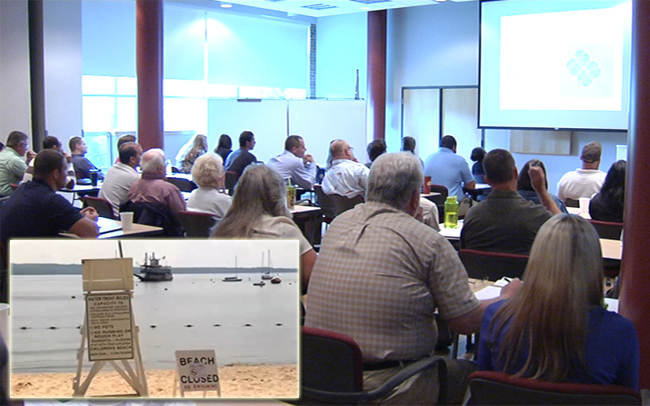
The audience—from Pennsylvania, Ohio, and New York—heard several experts provide an update on the algae. The idea was to share the information so that appropriate decisions could be made related to public health and safety during incidence of such blooms. In addition to having a potential impact on humans, these blooms are consuming oxygen in the waters, making it difficult for fish and other aquatic life to grow and thrive. Photos: WICU-TV/WSEE-TV; Composite by Paul C. Focazio, NYSG.
Research shows that algae thrives in calm, warm, nutrient rich water. Cutting phosphorus and nitrogen levels in the lake appears to be the key to controlling the algae blooms. And the experts think the local problem in Presque Isle Bay could stem from a 2011 major bloom in western Lake Erie that has moved east toward the Erie, PA area.
Justin Chaffin, Ph.D of Ohio State University said, "I would say the cyanobacteria that is occurring in the eastern basin now, is probably left over from the nutrients that occurred from Toledo in 2011." As for how to best deal with the situation, Chaffin says, "the only way to stop a bloom is to prevent a bloom by making sure that nutrients aren't getting into the lake."
Figuring out the best battle plan is critical, as a bloom along Presque Isle beaches could have a negative impact on tourism and the fishing industry. This is why local officials say they will apply the lessons learned in Ohio to provide the latest information available to local swimmers, boaters and fishermen.
Clearly, the conference shows the level of concern and the knowledge that working together is critical in dealing with the issue.
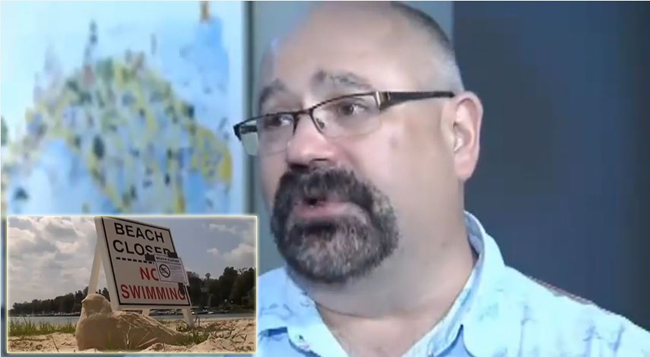
"This is an issue that effects all the Great Lakes and it has fairly serious implications for human and animal health as well as coastal economies," say New York Sea Grant Fisheries Specialist Dave MacNeill (pictured above), who is based at SUNY Oswego. "It's important because of all the partners involved that we collaborate." Photos: WICU-TV/WSEE-TV; Composite by Paul C. Focazio, NYSG.
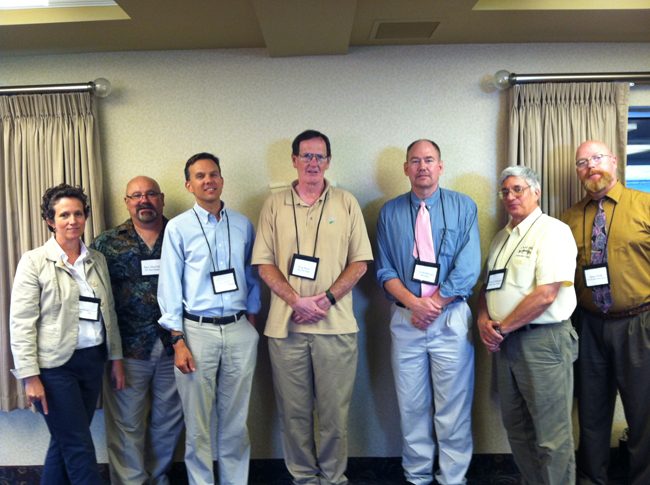
Some of the presenters and hosts from one of Sea Grant's July 2013's harmful algal blooms workshop held in upstate New York included: (l-r) New York Sea Grant's Associate Director Kathy Bunting-Howarth; NYSG Fisheries Specialist Dave Mac Neill; Stony Brook University School of Marine and Atmospheric Sciences investigator Chris Gobler; State University of New York (SUNY) College of Environmental Science & Forestry investigator Greg Boyer; NYSDEC Bureau of Water Assessment Management's Scott Kishbaugh; Ohio Sea Grant extension specialist Frank Lichtkoppler; New York State Department of Health's James Hyde. Photo: Courtesy of Helen Domske, NYSG.
More Info: New York Sea Grant
New York Sea Grant (NYSG), a cooperative program of Cornell University
and the State University of New York, is one of 33 university-based
programs under the National Sea Grant College Program (NSGCP) of the
National Oceanic and Atmospheric Administration (NOAA). The NSGCP
engages this network of the nation’s top universities in conducting
scientific research, education, training and extension projects designed
to foster science-based decisions about the use and conservation of our
aquatic resources. Through its statewide network of integrated
services, NYSG has been promoting coastal vitality, environmental
sustainability, and citizen awareness about the State’s marine and Great
Lakes resources since 1971.
For updates on Sea Grant activities: www.nyseagrant.org has RSS, Facebook, Twitter, and YouTube links. NYSG also offers a free e-list sign up via www.nyseagrant.org/coastlines for NY Coastlines, its flagship publication, which, in 2014, merges with the program's e-newsletter, Currents. NY Coastlines is published several times a year.